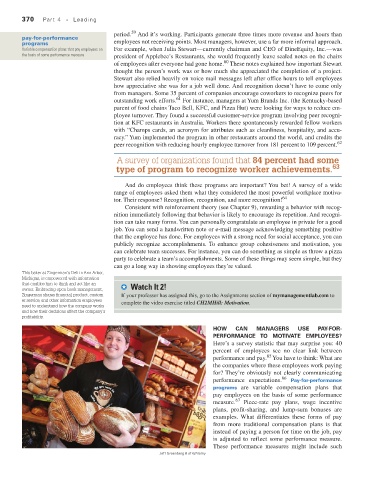Page 371 - Fundamentals of Management Myths Debunked (2017)_Flat
P. 371
370 Part 4 • Leading
59
period. And it’s working. Participants generate three times more revenue and hours than
pay-for-performance
programs employees not receiving points. Most managers, however, use a far more informal approach.
Variable compensation plans that pay employees on For example, when Julia Stewart—currently chairman and CEO of DineEquity, Inc.—was
the basis of some performance measure president of Applebee’s Restaurants, she would frequently leave sealed notes on the chairs
60
of employees after everyone had gone home. These notes explained how important Stewart
thought the person’s work was or how much she appreciated the completion of a project.
Stewart also relied heavily on voice mail messages left after office hours to tell employees
how appreciative she was for a job well done. And recognition doesn’t have to come only
from managers. Some 35 percent of companies encourage coworkers to recognize peers for
61
outstanding work efforts. For instance, managers at Yum Brands Inc. (the Kentucky-based
parent of food chains Taco Bell, KFC, and Pizza Hut) were looking for ways to reduce em-
ployee turnover. They found a successful customer-service program involving peer recogni-
tion at KFC restaurants in Australia. Workers there spontaneously rewarded fellow workers
with “Champs cards, an acronym for attributes such as cleanliness, hospitality, and accu-
racy.” Yum implemented the program in other restaurants around the world, and credits the
peer recognition with reducing hourly employee turnover from 181 percent to 109 percent. 62
A survey of organizations found that 84 percent had some
type of program to recognize worker achievements. 63
And do employees think these programs are important? You bet! A survey of a wide
range of employees asked them what they considered the most powerful workplace motiva-
tor. Their response? Recognition, recognition, and more recognition! 64
Consistent with reinforcement theory (see Chapter 9), rewarding a behavior with recog-
nition immediately following that behavior is likely to encourage its repetition. And recogni-
tion can take many forms. You can personally congratulate an employee in private for a good
job. You can send a handwritten note or e-mail message acknowledging something positive
that the employee has done. For employees with a strong need for social acceptance, you can
publicly recognize accomplishments. To enhance group cohesiveness and motivation, you
can celebrate team successes. For instance, you can do something as simple as throw a pizza
party to celebrate a team’s accomplishments. Some of these things may seem simple, but they
can go a long way in showing employees they’re valued.
This baker at Zingerman’s Deli in Ann Arbor,
Michigan, is empowered with information
that enables him to think and act like an Watch It 2!
owner. Embracing open-book management,
Zingerman shares financial, product, custom- If your professor has assigned this, go to the Assignments section of mymanagementlab.com to
er service, and other information employees complete the video exercise titled CH2MHill: Motivation.
need to understand how the company works
and how their decisions affect the company’s
profitability.
HoW can Managers Use Pay-for-
PerforMance to Motivate eMPloyees?
Here’s a survey statistic that may surprise you: 40
percent of employees see no clear link between
65
performance and pay. You have to think: What are
the companies where these employees work paying
for? They’re obviously not clearly communicating
66
performance expectations. Pay-for-performance
programs are variable compensation plans that
pay employees on the basis of some performance
67
measure. Piece-rate pay plans, wage incentive
plans, profit-sharing, and lump-sum bonuses are
examples. What differentiates these forms of pay
from more traditional compensation plans is that
instead of paying a person for time on the job, pay
is adjusted to reflect some performance measure.
These performance measures might include such
Jeff Greenberg 6 of 6/Alamy

